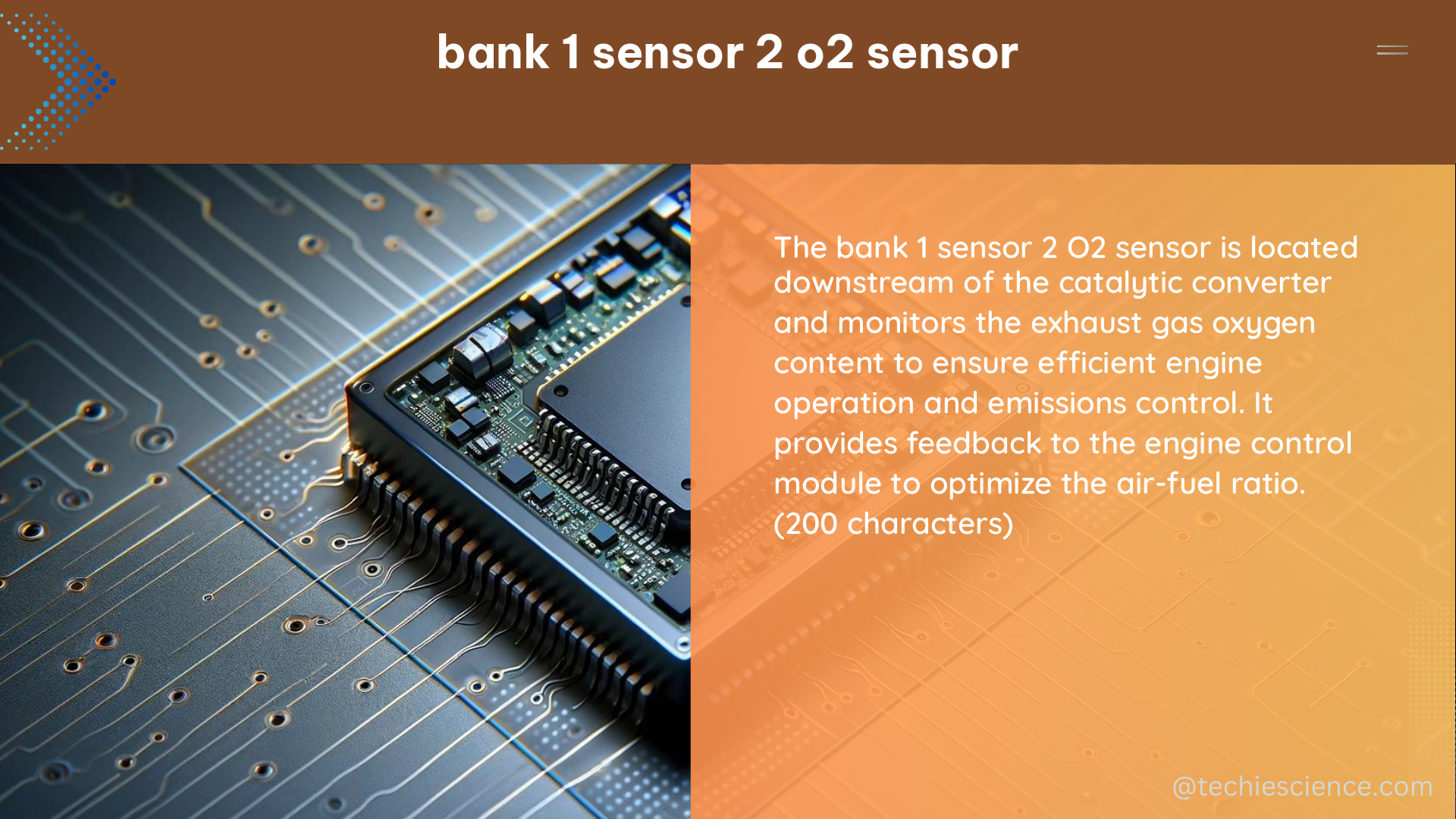The O2 sensor, also known as an oxygen sensor, is a critical component in the exhaust system of modern automotive engines. It plays a vital role in monitoring the air-fuel ratio and optimizing combustion efficiency to reduce emissions. Bank 1 sensor 2 O2 sensor specifically refers to the second oxygen sensor located in the exhaust stream of the engine’s bank 1, which is the side containing the first cylinder.
Understanding the Role of Bank 1 Sensor 2 O2 Sensor
The bank 1 sensor 2 O2 sensor is responsible for measuring the oxygen content in the exhaust gas after the air-fuel mixture has been combusted in the engine. This information is then sent to the engine control module (ECM), which uses it to adjust the fuel injection and ignition timing to maintain the optimal air-fuel ratio.
The sensor works by converting the oxygen level in the exhaust gas into a voltage signal. This voltage signal typically ranges from 0.1 to 1.0 volts, with a higher voltage indicating a lean air-fuel mixture (more oxygen) and a lower voltage indicating a rich air-fuel mixture (less oxygen).
Technical Specifications of Bank 1 Sensor 2 O2 Sensor

The technical specifications of the bank 1 sensor 2 O2 sensor can vary depending on the make and model of the vehicle, but there are some common features:
Sensing Element
The sensing element of the O2 sensor is typically made of zirconia or titania, which are materials that can detect the oxygen content in the exhaust gas and convert it into an electrical signal.
Heating Element
The sensor also has a heating element that helps it reach its operating temperature quickly, typically within 30 seconds of the engine starting. This is important because the sensor needs to be at the correct temperature to provide accurate readings.
Voltage Output
The voltage output range of the bank 1 sensor 2 O2 sensor is typically between 0.1 and 1.0 volts, with a higher voltage indicating a lean air-fuel mixture and a lower voltage indicating a rich air-fuel mixture.
Temperature Range
The sensor is designed to operate within a wide temperature range, typically from -40°C to 850°C, to withstand the harsh environment of the exhaust system.
Insulation and Housing
The sensor may also have a ceramic insulator and a stainless steel housing to protect it from the high temperatures, vibrations, and corrosive elements in the exhaust system.
Replacing the Bank 1 Sensor 2 O2 Sensor
Replacing the bank 1 sensor 2 O2 sensor is a relatively straightforward process, but it’s important to follow the proper steps to ensure a successful installation:
-
Locate the Sensor: The bank 1 sensor 2 O2 sensor is typically located near the exhaust manifold or close to the exhaust port of the first cylinder on the engine’s bank 1 side.
-
Remove the Sensor: Disconnect the electrical connector and remove any bolts or clamps holding the sensor in place. Use a special wrench or socket designed for O2 sensors to avoid damaging the sensor.
-
Clean the Area: Before installing the new sensor, clean the area around the sensor mounting point to remove any debris or corrosion that could affect the sensor’s performance.
-
Install the New Sensor: Carefully insert the new sensor into the mounting point and tighten it to the specified torque using the appropriate wrench or socket. Reconnect the electrical connector and ensure a secure connection.
-
Verify the Installation: After the new sensor is installed, start the engine and check for any diagnostic trouble codes related to the O2 sensor. If everything is working correctly, the engine should run smoothly, and the ECM should be able to maintain the optimal air-fuel ratio.
Importance of Regular Maintenance
Regular maintenance and inspection of the bank 1 sensor 2 O2 sensor are crucial to ensure the proper functioning of the engine’s emissions control system. Over time, the sensor can become contaminated or damaged, leading to inaccurate readings and potential engine performance issues.
It’s recommended to have the O2 sensor inspected and tested during routine maintenance intervals, such as oil changes or tune-ups. If the sensor is found to be faulty, it should be replaced promptly to avoid further damage to the engine or the catalytic converter.
Conclusion
The bank 1 sensor 2 O2 sensor is a critical component in the exhaust system of modern vehicles, responsible for monitoring the air-fuel ratio and optimizing combustion efficiency. Understanding its technical specifications, replacement process, and the importance of regular maintenance can help ensure your vehicle’s engine runs smoothly and efficiently while reducing emissions.
References:
- Oxygen Sensor Basics
- How to Replace an Oxygen Sensor
- O2 Sensor Specifications by Vehicle Make and Model

The lambdageeks.com Core SME Team is a group of experienced subject matter experts from diverse scientific and technical fields including Physics, Chemistry, Technology,Electronics & Electrical Engineering, Automotive, Mechanical Engineering. Our team collaborates to create high-quality, well-researched articles on a wide range of science and technology topics for the lambdageeks.com website.
All Our Senior SME are having more than 7 Years of experience in the respective fields . They are either Working Industry Professionals or assocaited With different Universities. Refer Our Authors Page to get to know About our Core SMEs.